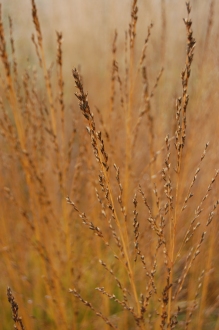Position: Full sun
Flowering period: Summer to early autumn
Soil: Moist, well drained
Eventual Height: 90cm
Eventual Spread: 60cm
Hardiness: 5a, 5b, 6a, 6b, 7a, 7b, 8a, 8b, 9a
Family: Poaceae
Molinia caerulea subsp. arundinacea is a tussock forming perennial grass, with a fine texture. Its mid green leaves are flat and taper to a point. Its leaves turn orange/ yellow in autumn. Its purple flowers appear in panicles, are up to 15cm long and appear above the leaves as a ‘haze’.
Molinia caerulea subsp. arundinacea, commonly known as Purple Moor Grass, is native to Europe (including the UK), Asia and North Africa. In its native habitat it grows in bogs, moorland and heathland. This grass is resistant to heath fires.
The etymological root of the binomial name Molinia is named after Juan Ignacio Molina (1740 – 1829), a Chilean naturalist. Caerulea is from the Latin meaning ‘blue’.
The landscape architect may find Molinia caerulea subsp. arundinacea useful as part of a prairie type planting scheme. Due to its tolerance of wet soils it is also suitable for use as part of a rain garden planting mix or SUDS scheme.
Ecologically, Molinia caerulea subsp. arundinacea seed is attractive to some birds.
Molinia caerulea subsp. arundinacea prefers moist, humus rich, well-drained soils. It prefers an acidic pH of soil. It is tolerant of wet soils.
Molinia caerulea subsp. arundinacea requires little maintenance. To keep a tidy appearance this grass may be cut to ground level as its leaves begin to wither. Large clumps may be divided in spring.







Leave a comment